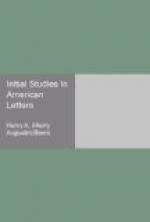It took eleven years to sell five hundred copies of this little book. But the year following its publication the remarkable Phi Beta Kappa address at Cambridge, on the American Scholar, electrified the little public of the university. This is described by Lowell as “an event without any former parallel in our literary annals, a scene to be always treasured in the memory for its picturesqueness and its inspiration. What crowded and breathless aisles, what windows clustering with eager heads, what grim silence of foregone dissent!” To Concord come many kindred spirits, drawn by Emerson’s magnetic attraction. Thither came, from Connecticut, Amos Bronson Alcott, born a few years before Emerson, whom he outlived; a quaint and benignant figure, a visionary and a mystic even among the transcendentalists themselves, and one who lived in unworldly simplicity the life of the soul. Alcott had taught school at Cheshire, Conn., and afterward at Boston on an original plan—compelling his scholars, for example, to flog him, when they did wrong, instead of taking a flogging themselves. The experiment was successful until his Conversations on the Gospels, in Boston, and his insistence upon admitting colored children to his benches, offended conservative opinion and broke up his school. Alcott renounced the eating of animal food in 1835. He believed in the union of thought and manual labor, and supported himself for some years by the work of his hands, gardening, cutting wood, etc. He traveled into the West and elsewhere, holding conversations on philosophy, education, and religion. He set up a little community at the village of Harvard, Massachusetts, which was rather less successful than Brook Farm, and he contributed Orphic Sayings to the Dial, which were harder for the exoteric to understand than even Emerson’s Brahma or the Over-soul.
Thither came, also, Sarah Margaret Fuller, the most intellectual woman of her time in America, an eager student of Greek and German literature and an ardent seeker after the True, the Good, and the Beautiful. She threw herself into many causes—such as temperance and the higher education of women. Her brilliant conversation classes in Boston attracted many “minds” of her own sex. Subsequently, as literary editor of the New York Tribune, she furnished a wider public with reviews and book notices of great ability. She took part in the Brook Farm experiment, and she edited the Dial for a time, contributing to it the papers afterward expanded into her most considerable book, Woman in the Nineteenth Century. In 1846 she went abroad, and at Rome took part in the revolutionary movement of Mazzini, having charge of one of the hospitals during the siege of the city by the French. In 1847 she married an impecunious Italian nobleman, the Marquis Ossoli. In 1850 the ship on which she was returning to America, with her husband and child,




